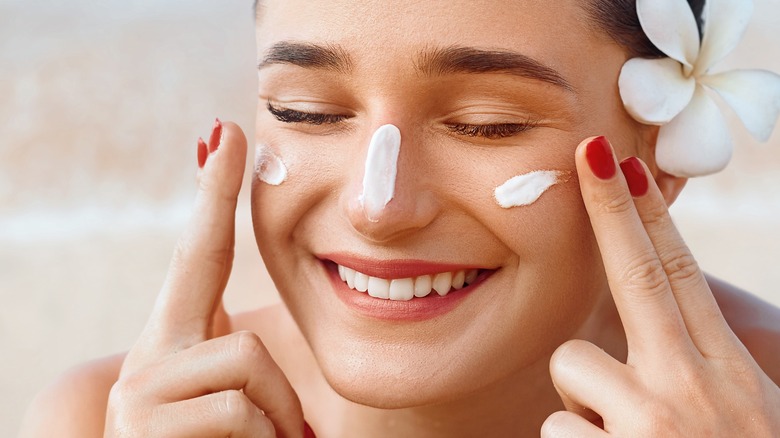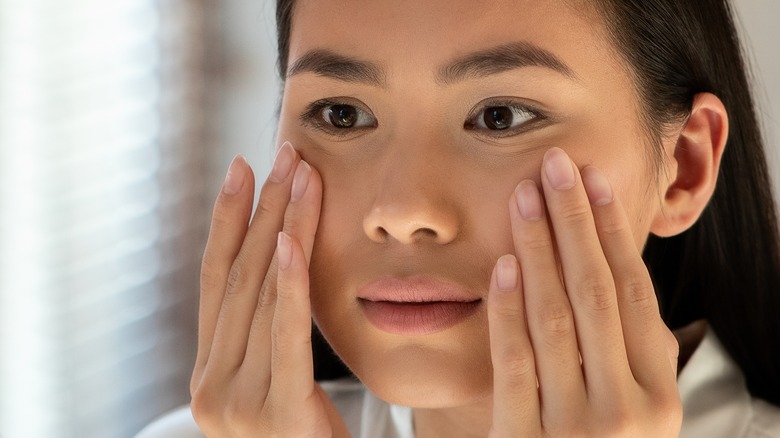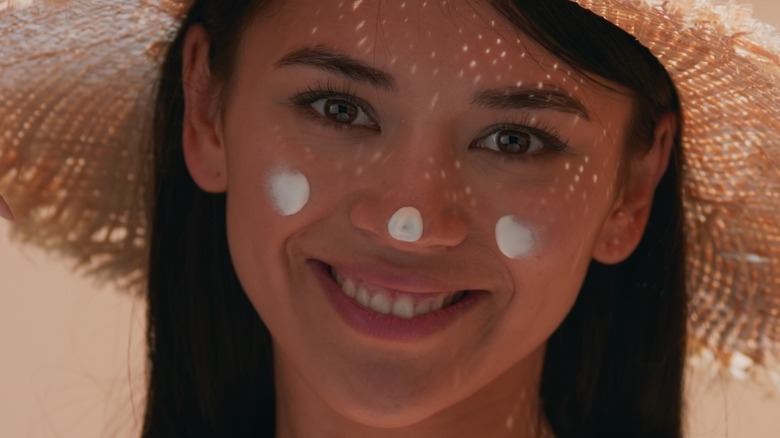Tinted Sunscreen Vs. Traditional SPF: Do The Skin Health Products Work The Same?
Sunscreen is the backbone of a good skincare routine. Slathering up with a sunblock with an SPF of 30 or greater before heading out is the biggest and the easiest favor you can do for your skin health. The benefits of sunscreen extend beyond aesthetic reasons. In addition to preventing free radicals from breaking down collagen, keratin, and elastin — the proteins that keep your skin smooth, blemish-free, and radiant — sunscreen also protects your skin from sunburn and minimizes risks of skin cancer. If you want to age beautifully, make anything with SPF your best friend.
Although all sunscreens protect your skin from damaging UV rays, many vary in formulation and packaging. Due to an insatiable demand for sunscreen, we're constantly seeing new variations and subcategories popping up. In recent years, many people are opting for tinted sunscreen, which contains pigment that helps people even out skin tone and hides flaws while protecting the skin. While it's great to have a skin health product that doubles up as a concealer, the versatility of tinted sunscreen raises the specter that it's just another spinoff of SPF makeup — which does not meet the FDA standards in terms of sun protection. So, is tinted sunscreen any better than its regular, non-tinted alternatives? Here are some insights.
The effect of sunlight on your skin
The much dreaded ultraviolet radiation — commonly called UV rays — has three types of wavelengths: UVA, UVB, and UVC. Making up 95% of sun rays is UVA, which has the longest wavelengths that penetrate the most deeply into the skin to cause damage to your skin cells. On the other hand, UVB rays have shorter wavelengths but are intense enough to wreak havoc on the outer layer of the skin and cause corneal problems. Exposure to UVC radiation — commonly found in artificial light sources such as tanning beds or lasers — can cause short-term skin wounds and eye injuries.
In general, overexposure to UVA can lead to premature skin aging and pigment darkening. Meanwhile, UVB — with higher energy levels — can damage your DNA by absorbing photons by non-DNA molecules, leading to skin cancers. Although UVC has the shortest wavelength and the lowest penetration power out of the three UV rays, prolonged exposure can still damage your skin and increase the risks of skin cancer.
The difference between physical and chemical sunscreens
Generally speaking, there are only two types of sunscreen: chemical and physical. Both act like body armor that helps absorb the impact and minimize the effect of UV radiation on the skin, but there's a difference in the way they work. Chemical sunscreens prevent UV rays from inflicting damage on the skin by absorbing them and transforming them into heat before releasing them from the skin. On the other hand, physical sunscreens — also known as mineral-based sunscreens — sit on top of the skin to put up a barrier on the skin surface that scatters UV rays and prevents them from reaching the skin.
The UV filtering ingredients commonly found in chemical sunscreens include avobenzone, octinoxate, and oxybenzone, which effectively absorb UVA and UVB rays, curtailing their skin penetration levels and minimizing the risks of DNA damage. Designed for quick skin absorption, chemical sunscreens are more water and sweat-resistant. Physical sunscreens, meanwhile, contain primarily zinc oxide and titanium dioxide — two naturally occurring minerals that are powerful in blocking a sizable fraction of the UVB and UVA photons and are currently FDA-approved to be used on the skin. As with any mineral-based formula, physical sunscreens are harder to absorb and thus synonymous with the post-application white cast.
It doesn't matter which sunscreen you use; as far as sun safety goes, you'll need approximately one ounce of sunscreen — enough to cover your palm — to cover your face, arms, and legs for each use.
What is tinted sunscreen?
Tinted sunscreens are mineral-based sunscreens that contain added pigments. "Tinted sunscreens combine a colored base coverage with UV filters," dermatologist Dr. Jodi LoGerfo tells Yahoo News. Combining broad-spectrum mineral UV filters such as zinc oxide and titanium dioxide with added pigments, tinted sunscreens offer SPF coverage that blends seamlessly into the skin instead of leaving behind a chalky white residue common to traditional SPF applications. Tinted sunscreens can also camouflage facial imperfections, which even chemical sunscreens cannot do.
The visible, skin-tone pigments of tinted sunscreens, inactive and well-tolerated by nature, are obtained by combining black, red, and yellow iron oxides with pigmentary titanium dioxides. Tinted sunscreens exist in a broad range of shades, meaning they can match any skin tone. You can wear tinted sunscreen under makeup or wear it alone, which offers SPF coverage worthy of a CC cream quality that evens out hyperpigmentation and lends your skin a natural glow.
Tinted sunscreen might be superior to non-tinted SPF
The reason why tinted sunscreens are next in skin health products extends way beyond their skin surface benefits. Not only can tinted sunscreens fulfill the aesthetic need of evening out skin tone and hiding imperfections with minimal effort, but they can also protect the skin from damage caused by both UV radiation and visible light. On the other hand, traditional SPF — or non-tinted sunscreens — cannot block visible light.
Like UV radiation, visible light also belongs in the electromagnetic spectrum. The sun is the dominant source of visible-light waves that human eyes can see. Blue light is a prime example of visible light. Other visible light sources are found in lightbulbs, medical devices, television and computer screens, signal flares, and fireworks. UV rays and visible light negatively affect the skin, but the intensity of the damage caused by each varies. Visible light can penetrate the skin deeper than UV radiation, damaging skin cells and causing pigmentation that lasts longer than that caused by UV radiation. Generally speaking, sunscreens must be visible on the skin to block visible light, and non-tinted sunscreens are not designed with visibility in mind. This means, in terms of protecting the skin from both sunlight and artificial light sources, tinted sunscreens can do a much better job than non-tinted ones.
Who benefit from tinted sunscreens
If you're prone to hyperpigmentation or melasma — a skin condition characterized by brown or blue-gray spots on the skin — make tinted sunscreens your next best friend. Blue light, a high-energy visible light, manipulates melanin production in your skin cells, which can cause or exacerbate hyperpigmentation. Since tinted sunscreens are effective in counteracting blue light, they can be helpful to those with skin conditions related to hyperpigmentation, such as age spots or acne scars.
Many studies show that tinted sunscreens are more effective than non-tinted, broad-spectrum sunscreens at preventing hyperpigmentation on the skin's surface and under a microscope. The reason is the heat is generated due to a chemical reaction between the chemical UV filters, and UV rays can irritate those with sensitive skin. If your skin is vulnerable to irritations, you might want to do a patch test before using a specific tinted sunscreen.
Since tinted sunscreens effectively control shine and absorb excess oil on the face, they might just be what the doctor ordered for those with oily skin. If you have dry skin, you might want to hydrate your skin with a moisturizer before layering tinted sunscreen unless the formulation contains moisturizing properties. If you have acne-prone skin, consider finding a non-comedogenic and oil-free formula to avoid worsening your breakouts while minimizing the symptoms of hyperpigmentation.
How to use tinted sunscreen
When buying tinted sunscreens, find one with an SPF of at least 30. To avoid clogging your pores, look for a formulation that includes the term "non-comedogenic" or one containing non-comedogenic ingredients like zinc oxide and titanium dioxide.
If you have oily or combination skin, use ingredients that help regulate your oil production and make your skin feel less oily, such as ceramide, hyaluronic acid, niacinamide, green tea extract, silicone, and L-carnitine. Texture-wise, opt for a gel-based or liquid-based formula that feels light on the skin and doesn't clog pores. If you have sensitive and dry skin, use a moisturizing, cream-like sunscreen with minimal fragrance. Hyaluronic acid, glycerin, ceramides, and aloe vera are some hydrating ingredients to look for in a tinted sunscreen.
As far as application goes, use at least a teaspoon of SPF to cover your face and neck and continue layering as needed. When removing tinted sunscreen, a recommended way is to use a makeup remover to lift the heavy mineral-based ingredients off your skin first, followed by a thorough wash with an oil-based cleanser. Another way to go about it is to use an oil cleanser for the first cleanse and a treatment cleanser with deep cleansing and pore unclogging power to eliminate impurities and soothe your skin. After double cleansing, lather with a moisturizer to trap in hydration.






